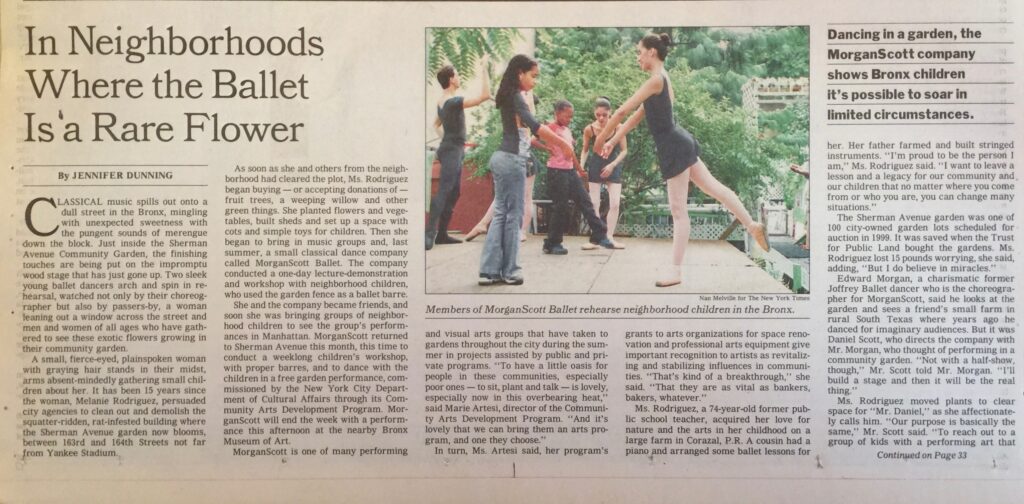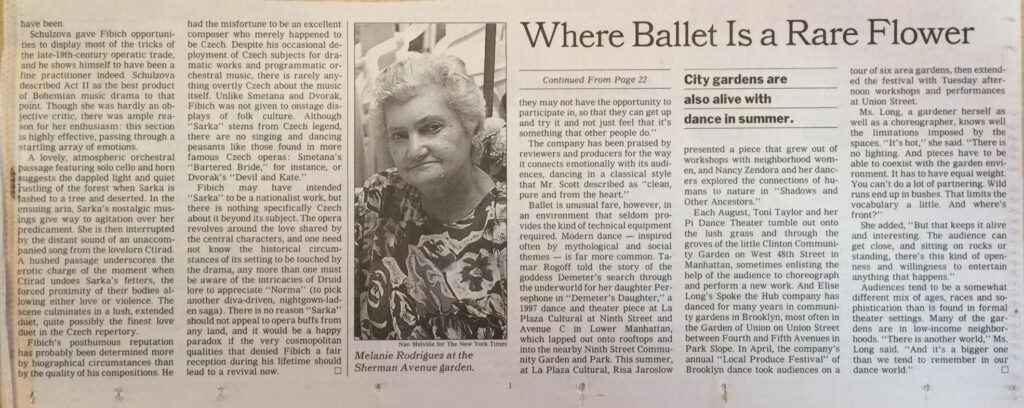

DANCE; In Neighborhoods Where the Ballet Is a Rare Flower By JENNIFER DUNNING Published: August 19, 2001 CLASSICAL music spills out onto a dull street in the Bronx, mingling with unexpected sweetness with the pungent sounds of merengue down the block. Just inside the Sherman Avenue Community Garden, the finishing touches are being put on the impromptu wood stage that has just gone up. Two sleek young ballet dancers arch and spin in rehearsal, watched not only by their choreographer but also by passers-by, a woman leaning out a window across the street and men and women of all ages who have gathered to see these exotic flowers growing in their community garden. A small, fierce-eyed, plainspoken woman with graying hair stands in their midst, arms absent-mindedly gathering small children about her. It has been 15 years since the woman, Melanie Rodriguez, persuaded city agencies to clean out and demolish the squatter-ridden, rat-infested building where the Sherman Avenue garden now blooms, between 163rd and 164th Streets not far from Yankee Stadium. As soon as she and others from the neighborhood had cleared the plot, Ms. Rodriguez began buying — or accepting donations of — fruit trees, a weeping willow and other green things. She planted flowers and vegetables, built sheds and set up a space with cots and simple toys for children. Then she began to bring in music groups and, last summer, a small classical dance company called MorganScott Ballet. The company conducted a one-day lecture-demonstration and workshop with neighborhood children, who used the garden fence as a ballet barre. She and the company became friends, and soon she was bringing groups of neighborhood children to see the group’s performances in Manhattan. MorganScott returned to Sherman Avenue this month, this time to conduct a weeklong children’s workshop, with proper barres, and to dance with the children in a free garden performance, commissioned by the New York City Department of Cultural Affairs through its Community Arts Development Program. MorganScott will end the week with a performance this afternoon at the nearby Bronx Museum of Art. MorganScott is one of many performing and visual arts groups that have taken to gardens throughout the city during the summer in projects assisted by public and private programs. ”To have a little oasis for people in these communities, especially poor ones — to sit, plant and talk — is lovely, especially now in this overbearing heat,” said Marie Artesi, director of the Community Arts Development Program. ”And it’s lovely that we can bring them an arts program, and one they choose.” In turn, Ms. Artesi said, her program’s grants to arts organizations for space renovation and professional arts equipment give important recognition to artists as revitalizing and stabilizing influences in communities. ”That’s kind of a breakthrough,” she said. ”That they are as vital as bankers, bakers, whatever.” Ms. Rodriguez, a 74-year-old former public school teacher, acquired her love for nature and the arts in her childhood on a large farm in Corazal, P.R. A cousin had a piano and arranged some ballet lessons for her. Her father farmed and built stringed instruments. ”I’m proud to be the person I am,” Ms. Rodriguez said. ”I want to leave a lesson and a legacy for our community and our children that no matter where you come from or who you are, you can change many situations.” The Sherman Avenue garden was one of 100 city-owned garden lots scheduled for auction in 1999. It was saved when the Trust for Public Land bought the gardens. Ms. Rodriguez lost 15 pounds worrying, she said, adding, ”But I do believe in miracles.” Edward Morgan, a charismatic former Joffrey Ballet dancer who is the choreographer for MorganScott, said he looks at the garden and sees a friend’s small farm in rural South Texas where years ago he danced for imaginary audiences. But it was Daniel Scott, who directs the company with Mr. Morgan, who thought of performing in a community garden. ”Not with a half-show, though,” Mr. Scott told Mr. Morgan. ”I’ll build a stage and then it will be the real thing.” Ms. Rodriguez moved plants to clear space for ”Mr. Daniel,” as she affectionately calls him. ”Our purpose is basically the same,” Mr. Scott said. ”To reach out to a group of kids with a performing art that they may not have the opportunity to participate in, so that they can get up and try it and not just feel that it’s something that other people do.” The company has been praised by reviewers and producers for the way it connects emotionally with its audiences, dancing in a classical style that Mr. Scott described as ”clean, pure and from the heart.” Ballet is unusual fare, however, in an environment that seldom provides the kind of technical equipment required. Modern dance — inspired often by mythological and social themes — is far more common. Tamar Rogoff told the story of the goddess Demeter’s search through the underworld for her daughter Persephone in ”Demeter’s Daughter,” a 1997 dance and theater piece at La Plaza Cultural at Ninth Street and Avenue C in Lower Manhattan, which lapped out onto rooftops and into the nearby Ninth Street Community Garden and Park. This summer, at La Plaza Cultural, Risa Jaroslow presented a piece that grew out of workshops with neighborhood women, and Nancy Zendora and her dancers explored the connections of humans to nature in ”Shadows and Other Ancestors.” Each August, Toni Taylor and her Pi Dance Theater tumble out onto the lush grass and through the groves of the little Clinton Community Garden on West 48th Street in Manhattan, sometimes enlisting the help of the audience to choreograph and perform a new work. And Elise Long’s Spoke the Hub company has danced for many years in community gardens in Brooklyn, most often in the Garden of Union on Union Street between Fourth and Fifth Avenues in Park Slope. In April, the company’s annual ”Local Produce Festival” of Brooklyn dance took audiences on a tour of six area gardens, then extended the festival with Tuesday afternoon workshops and performances at Union Street. Ms. Long, a gardener herself as well as a choreographer, knows well the limitations imposed by the spaces. ”It’s hot,” she said. ”There is no lighting. And pieces have to be able to coexist with the garden environment. It has to have equal weight. You can’t do a lot of partnering. Wild runs end up in bushes. That limits the vocabulary a little. And where’s front?” She added, ”But that keeps it alive and interesting. The audience can get close, and sitting on rocks or standing, there’s this kind of openness and willingness to entertain anything that happens.” Audiences tend to be a somewhat different mix of ages, races and sophistication than is found in formal theater settings. Many of the gardens are in low-income neighborhoods. ”There is another world,” Ms. Long said. ”And it’s a bigger one than we tend to remember in our dance world.” Photos: Members of MorganScott Ballet rehearse neighborhood children in the Bronx. (Nan Melville for The New York Times)(pg. 22); Melanie Rodriguez at the Sherman Avenue garden. (Nan Melville for The New York Times)(pg. 33) |